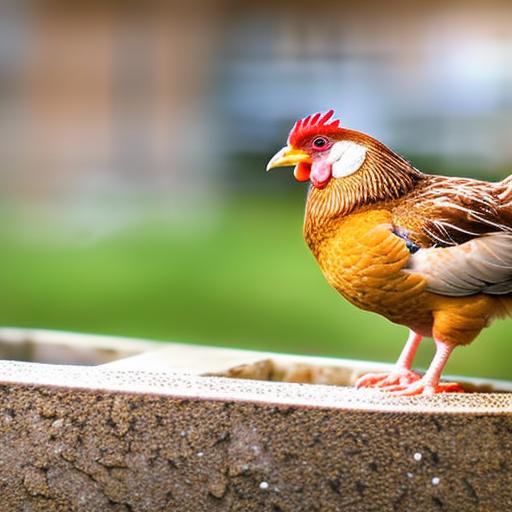Urban chicken keeping is a growing trend in cities around the world. More and more people are choosing to raise chickens in their backyard, even in urban areas where space is limited. This practice allows city dwellers to enjoy the benefits of fresh eggs, have chickens as pets, and contribute to a more sustainable and environmentally friendly lifestyle.
Key Takeaways
- Raising chickens in the city has numerous benefits, including access to fresh eggs, natural pest control, and a fun hobby.
- Before starting urban chicken keeping, it’s important to research and follow city regulations for keeping chickens.
- When choosing a chicken breed for city living, consider factors such as noise level, temperament, and egg production.
- Building a chicken coop requires careful consideration of factors such as size, location, and materials.
- Maintaining a chicken coop involves regular cleaning, feeding, and monitoring for signs of illness.
Benefits of Raising Chickens in the City
One of the main benefits of raising chickens in the city is having a constant supply of fresh eggs. Unlike store-bought eggs, which may have been sitting on shelves for weeks, eggs from backyard chickens are incredibly fresh and flavorful. They also tend to have a richer yolk color and a firmer texture. Additionally, raising your own chickens allows you to have control over their diet and living conditions, ensuring that they are healthy and producing high-quality eggs.
Another benefit of urban chicken keeping is the companionship and entertainment that chickens can provide. Chickens are social animals and can form strong bonds with their owners. They are also surprisingly intelligent and can be trained to perform simple tricks or respond to commands. Many people find great joy in spending time with their chickens, watching them scratch around the yard or listening to their gentle clucking.
From an environmental perspective, urban chicken keeping has several advantages. Chickens are excellent at recycling kitchen scraps and yard waste into nutrient-rich compost. They also eat insects and pests, reducing the need for chemical pesticides. Additionally, raising chickens in the city can help reduce food miles by providing a local source of eggs, thus decreasing the carbon footprint associated with transporting eggs from rural areas to urban centers.
City Regulations for Keeping Chickens
Before embarking on your urban chicken keeping journey, it is important to familiarize yourself with the regulations in your city regarding keeping chickens. Many cities have specific rules and guidelines that must be followed in order to keep chickens legally. These regulations often cover aspects such as the number of chickens allowed, coop size and design, noise restrictions, and proximity to neighboring properties.
Following these regulations is crucial for several reasons. Firstly, it ensures that you are being a responsible and considerate neighbor. By adhering to the rules, you can minimize any potential conflicts or complaints from neighbors who may be concerned about noise, odors, or other issues associated with keeping chickens. Secondly, complying with the regulations helps to maintain the integrity of urban chicken keeping as a legitimate and respected practice. By demonstrating that you are following the rules, you contribute to the positive image of urban chicken keeping in your community.
To find out the specific regulations in your city, it is best to consult your local government’s website or contact your city’s animal control department. They will be able to provide you with the most up-to-date information regarding the rules and guidelines for keeping chickens in your area. Additionally, there are online resources and forums where urban chicken keepers share information and experiences, which can be a valuable source of knowledge and support.
Choosing the Right Chicken Breed for City Living
When it comes to choosing the right chicken breed for city living, there are several factors to consider. Different breeds have different characteristics in terms of size, temperament, egg production, and noise level. It is important to choose a breed that is well-suited to your specific needs and circumstances.
Some breeds are better suited for urban environments than others. For example, smaller breeds such as bantams or miniature chickens are a popular choice for city dwellers due to their compact size and lower space requirements. They are also generally quieter than larger breeds. Additionally, some breeds are known for being more docile and friendly, which can be an important consideration if you have children or plan on interacting with your chickens frequently.
To help you choose the right breed for you, there are several resources available online that provide detailed information on different chicken breeds. These resources often include descriptions of each breed’s characteristics, such as size, temperament, egg production, and noise level. They can help you make an informed decision based on your specific preferences and circumstances.
Building a Chicken Coop: Factors to Consider
Building a chicken coop is an essential part of urban chicken keeping. The coop provides a safe and comfortable space for your chickens to live and lay eggs. When designing and building a chicken coop, there are several factors to consider.
Firstly, the size of the coop is an important consideration. The general rule of thumb is to allow at least 4 square feet of space per chicken inside the coop, and 10 square feet per chicken in the outdoor run. However, it is always better to err on the side of caution and provide more space if possible. Chickens that are overcrowded can become stressed and may exhibit aggressive behavior or develop health issues.
The location of the coop is also important. It should be situated in an area that receives adequate sunlight and is well-drained to prevent waterlogging. It should also be easily accessible for cleaning and maintenance. Additionally, consider the proximity of the coop to your neighbors’ properties to minimize any potential disturbances or conflicts.
Predator-proofing your coop is crucial to ensure the safety of your chickens. Urban areas may still have predators such as raccoons, foxes, or rats that can pose a threat to your flock. Make sure that the coop is securely built with sturdy materials and has no gaps or openings that predators can squeeze through. Reinforce doors and windows with hardware cloth or wire mesh to prevent entry.
Chicken Coop Design: Tips and Tricks

Designing a functional and attractive chicken coop requires careful planning and consideration. Here are some tips and tricks to help you create a coop that meets your needs:
1. Ventilation: Proper ventilation is essential to maintain good air quality inside the coop and prevent the buildup of moisture and ammonia. Include windows or vents that can be opened and closed to allow for airflow.
2. Lighting: Chickens require natural light to maintain their circadian rhythm and lay eggs consistently. Include windows or skylights in the coop to provide ample natural light during the day. You can also install artificial lighting to supplement natural light during the winter months.
3. Nesting Boxes: Provide enough nesting boxes for your chickens to lay their eggs. A general guideline is to have one nesting box for every 3-4 hens. The boxes should be dark and secluded to provide a sense of privacy and security for the hens.
4. Roosting Bars: Chickens naturally roost at night, so it is important to provide roosting bars inside the coop. These should be elevated off the ground and wide enough for the chickens to comfortably perch on.
5. Easy Cleaning: Design the coop with easy cleaning in mind. Include features such as removable trays or droppings boards under the roosting bars to collect droppings, making it easier to clean and maintain a hygienic environment.
Creating a comfortable environment for your chickens is essential for their health and well-being. Provide ample bedding material such as straw or wood shavings on the coop floor to absorb moisture and provide insulation. Consider adding perches, ramps, or platforms for your chickens to perch on or explore, as this can help keep them entertained and prevent boredom.
Materials Needed for Building a Chicken Coop
Building a chicken coop requires several materials, but it doesn’t have to break the bank. Here are some common materials needed for building a chicken coop:
1. Lumber: Lumber is one of the main materials needed for building a chicken coop. You will need it for framing, walls, and flooring. Opt for pressure-treated lumber or cedar, as they are more resistant to rot and pests.
2. Wire Mesh: Wire mesh is essential for predator-proofing your coop. Use a heavy-duty wire mesh with small openings to prevent predators from entering. Galvanized or stainless steel wire mesh is recommended for its durability.
3. Roofing Material: Choose a roofing material that is weather-resistant and provides adequate protection from the elements. Options include asphalt shingles, metal roofing, or corrugated plastic sheets.
4. Hardware: You will need various hardware items such as screws, nails, hinges, latches, and brackets to assemble the coop. Opt for galvanized or stainless steel hardware to prevent rusting.
5. Insulation: Depending on your climate, you may need insulation to regulate the temperature inside the coop. Insulating materials such as foam board or fiberglass batts can help keep the coop warm in winter and cool in summer.
Affordable materials can often be found at local hardware stores, salvage yards, or online marketplaces. Additionally, consider repurposing materials whenever possible. For example, old pallets can be used to build walls or flooring, and discarded windows or doors can be repurposed for ventilation or access points.
Step-by-Step Guide to Building a Chicken Coop
Building a chicken coop may seem like a daunting task, but with proper planning and guidance, it can be a rewarding DIY project. Here is a step-by-step guide to help you build your own chicken coop:
1. Design: Start by designing your chicken coop on paper or using design software. Consider factors such as size, layout, and materials needed. Take into account the number of chickens you plan to keep and any specific requirements they may have.
2. Gather Materials: Once you have your design finalized, gather all the necessary materials and tools needed for the construction process.
3. Prepare the Site: Clear the area where you plan to build the coop and level the ground if necessary. Remove any obstacles or debris that may interfere with the construction process.
4. Build the Frame: Start by building the frame of the coop using the lumber. Cut the pieces according to your design and assemble them using screws or nails. Make sure the frame is sturdy and level.
5. Install Walls and Roof: Once the frame is complete, install the walls and roof. Use plywood or other suitable materials for the walls, and roofing material of your choice for the roof. Secure everything in place using screws or nails.
6. Add Windows and Ventilation: Cut openings for windows and vents according to your design. Install hardware cloth or wire mesh over these openings to prevent predators from entering.
7. Install Nesting Boxes and Roosting Bars: Install nesting boxes and roosting bars inside the coop. Make sure they are securely attached to the walls or frame.
8. Add Flooring and Bedding: Install flooring material such as plywood or vinyl, and cover it with bedding material such as straw or wood shavings.
9. Add Doors and Access Points: Install doors and access points to allow for easy entry and exit from the coop. Make sure they are secure and can be locked to prevent predators from entering.
10. Predator-Proofing: Inspect the coop for any gaps or openings that predators could exploit. Reinforce these areas with additional wire mesh or hardware cloth.
11. Finishing Touches: Add any finishing touches such as paint, stain, or weatherproofing to protect the coop from the elements and make it visually appealing.
Remember to take breaks when needed, follow safety precautions, and seek assistance if necessary. Building a chicken coop can be a time-consuming process, but with patience and perseverance, you will have a functional and attractive coop for your chickens.
Maintaining a Chicken Coop: Best Practices
Maintaining a chicken coop is essential for the health and well-being of your chickens. Here are some best practices to keep in mind:
1. Cleanliness: Regularly clean the coop to remove droppings, soiled bedding, and any debris. A clean coop helps prevent the buildup of bacteria and parasites that can harm your chickens.
2. Bedding: Replace bedding material regularly to maintain a clean and comfortable environment for your chickens. Add fresh bedding as needed to keep the coop dry and odor-free.
3. Feeding and Watering: Provide fresh food and water for your chickens daily. Clean and refill their feeders and waterers regularly to prevent contamination.
4. Pest Control: Implement pest control measures to prevent infestations of mites, lice, or other pests that can harm your chickens. Regularly inspect the coop for signs of pests and take appropriate action if necessary.
5. Health Checks: Regularly inspect your chickens for signs of illness or injury. Monitor their behavior, appetite, and egg production to ensure they are healthy and thriving. Consult a veterinarian if you notice any abnormalities or concerns.
6. Egg Collection: Collect eggs daily to prevent them from being damaged or eaten by your chickens. Handle eggs with care to avoid cracking or contaminating them.
7. Seasonal Considerations: Adjust your maintenance routine according to the seasons. In colder months, provide additional insulation or heat sources to keep the coop warm. In hotter months, ensure adequate ventilation and provide shade to keep the coop cool.
By following these best practices, you can create a clean and healthy environment for your chickens, ensuring their well-being and productivity.
Enjoying Fresh Eggs in the City
Urban chicken keeping offers numerous benefits, from enjoying fresh eggs to having chickens as pets and contributing to a more sustainable lifestyle. By following city regulations, choosing the right breed, building a well-designed coop, and maintaining it properly, you can successfully raise chickens in the city.
Remember to do your research, consult local regulations, and seek advice from experienced urban chicken keepers. There are many resources available online and in your community to help you get started and navigate the challenges of urban chicken keeping.
So why not give it a try? With a little time, effort, and dedication, you can enjoy the rewards of fresh eggs, the companionship of chickens, and the satisfaction of living a more sustainable lifestyle right in the heart of the city.
If you’re wondering whether you can keep chickens in the city, you’ll be glad to know that it’s possible with the right setup. One important aspect of raising chickens is ensuring they have a suitable place to lay their eggs. In this informative article on Poultry Wizard, you can learn about the fascinating behavior of quails sitting on their eggs. Understanding this process is crucial for successful breeding and egg production. To create a comfortable environment for your urban flock, you may also want to explore the benefits of an A-frame chicken coop, as discussed in this helpful article. Additionally, the article on choosing the right floor for your chicken coop provides valuable insights into creating a clean and hygienic space for your feathered friends.
FAQs
What are the benefits of keeping chickens in the city?
Keeping chickens in the city can provide a source of fresh eggs, fertilizer for gardens, and entertainment for families. Chickens can also help control pests and weeds in the yard.
What are the legal requirements for keeping chickens in the city?
The legal requirements for keeping chickens in the city vary depending on the location. Some cities have specific regulations regarding the number of chickens allowed, coop size and placement, and noise restrictions. It is important to check with local authorities before keeping chickens in the city.
What kind of space do chickens need?
Chickens need a coop for shelter and a run for exercise. The coop should be large enough for the number of chickens being kept and provide protection from predators. The run should be fenced and provide at least 10 square feet of space per chicken.
What do chickens eat?
Chickens eat a variety of foods including commercial chicken feed, grains, fruits, vegetables, and insects. It is important to provide a balanced diet for chickens to ensure their health and egg production.
What are the health risks associated with keeping chickens in the city?
Chickens can carry diseases such as salmonella, which can be transmitted to humans through contact with their feces or eggs. It is important to practice good hygiene when handling chickens and their eggs to reduce the risk of illness.
What should I do with chicken waste?
Chicken waste can be composted and used as fertilizer for gardens. It is important to properly dispose of chicken waste to prevent odors and attract pests.
Meet Walter, the feathered-friend fanatic of Florida! Nestled in the sunshine state, Walter struts through life with his feathered companions, clucking his way to happiness. With a coop that’s fancier than a five-star hotel, he’s the Don Juan of the chicken world. When he’s not teaching his hens to do the cha-cha, you’ll find him in a heated debate with his prized rooster, Sir Clucks-a-Lot. Walter’s poultry passion is no yolk; he’s the sunny-side-up guy you never knew you needed in your flock of friends!







